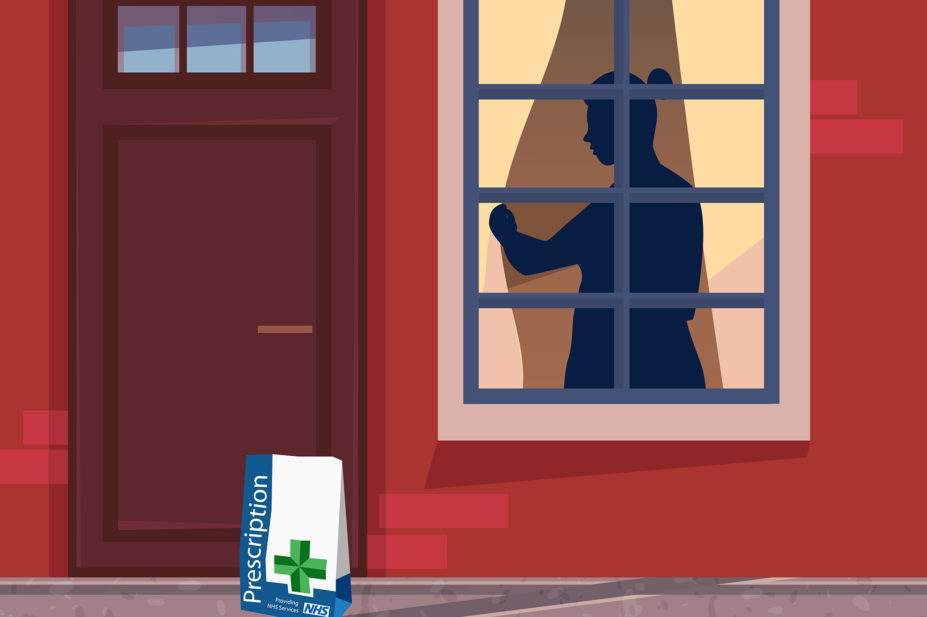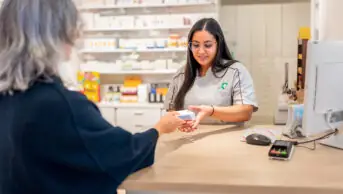
Mclean/Shutterstock.com
The COVID-19 pandemic brought into acute focus the needs of society’s most vulnerable people.
While data on the number of housebound patients is not readily available, recent publications suggest there are around 470,000 people who fall into this category in the UK — a number that skyrocketed during the pandemic, when nearly 4 million people were told to shield from COVID-19 in their homes[1].
The surge in patients restricted to their homes posed several challenges, particularly as a cohort that, by definition, has more complex needs and relies heavily on regular medicines deliveries. In response, NHS England set up a community pharmacy medicines delivery service in April 2020 to deliver medicines to clinically extremely vulnerable patients who were shielding on the advice of the government. Between April 2020 and March 2021, 9,069 community pharmacies made 5.57 million deliveries to patients[2].
As part of our research published in the International Journal of Pharmacy Practice, we interviewed 50 people from England, Wales and Scotland who were shielding and/or over the age of 70 years during the first wave of the pandemic between June and August 2020, and asked them about their experiences of managing their medicines and any challenges they faced[3].
Our findings reveal the vital role that community pharmacy staff played in the care of patients during the pandemic, and this highlights all that the sector could offer through a suite of nationally commissioned essential services for housebound patients.
A reliable delivery service
An important benefit of a nationally commissioned service would be the consistency it provides patients across the country.
The people we spoke to as part of our research all seemed to have had very different experiences in relation to arranging home delivery of medicines while staying at home. Some spoke of how pharmacy staff had gone out of their way to help by proactively calling them to see if they needed their medicines delivered and arranging delivery quickly when asked, while others said they had found it very difficult to get in contact with their pharmacies as phone lines were constantly engaged or that their pharmacy was unable or reluctant to deliver medicines. This may be because pharmacies were only reimbursed for delivering to those patients on the official shielding list, which was later expanded to include 1.7 million more patients in February 2021. Pharmacies were also required to check if other people, such as friends, family, or volunteers, were able to collect medicines before offering to deliver.
A nationally commissioned essential service to deliver medicines could avoid these pitfalls by requiring pharmacies to have a delivery service in place and funding it appropriately. This has worked well in other parts of the world. For example, in New Zealand, a survey of 905 evaluable pharmacies, of which 403 responded, found that 90% provided home deliveries, with pharmacists saying that these services — along with providing compliance packaging — were thought to be most beneficial for older patients in helping with medicines adherence[4].
The importance of video consultations for housebound patients
Housebound patients face several potential challenges that require pharmacy staff assistance, aside from obtaining medicines. These include having fewer opportunities to communicate with pharmacists and other healthcare professionals about their prescriptions, which can in turn lead to medicines omissions, a lack of medicines optimisation and considerable health-related anxiety for the patient[5].
The value of pharmacists conducting domiciliary medicine reviews was made clear in research published in 2019 by Kingston University in London, suggesting that visits to housebound patients by pharmacists could help identify a wide range of care needs in this cohort, including difficulties in taking medicines, fall hazards and inadequate social care[6]. The researchers also suggested pharmacist visits could help integrate care requirements for housebound patients[6].
In addition, these visits have the potential to benefit other parts of the NHS. A 2018 study by the University of Nottingham evaluated a pilot project for pharmacies in Nottinghamshire and Derbyshire to provide medicines use reviews (MURs) to housebound patients, and found that more than one third of the 1,092 MURs conducted had contributed towards preventing either a possible or likely emergency hospital admission[7].
However, our findings suggest pharmacists could expand on these services to include other pharmacy consultations, such as responding to queries about symptoms and medication consultations outside of these reviews. The patients we spoke to as part of our research appreciated receiving advice from their pharmacist over the phone in response to various queries about symptoms. However, they also reported their limitations — for example, one person stated that they “wished that [the pharmacist] could look at these rashes, even online”.
Studies have shown that video consultations are effective in other healthcare settings. Researchers at the University of Toronto, Canada, conducted a meta-analysis of randomised trials to determine patient and surgeon satisfaction with telemedicine. Of the 12 articles covering more than 1,000 patients, researchers found there was no difference in the odds of satisfaction between patients receiving telemedicine care and those receiving in-person care[8].
Policymakers should therefore consider commissioning pharmacists to conduct medicines-related consultations with housebound patients using video consultation platforms.
The benefits of personal care
Nothing can replace personal care. Through our research, we identified that relationships with pharmacy staff were found to be one of the main factors that enabled a smooth transition from pre-pandemic once patients were staying at home. People particularly appreciated the ‘community’ focus of pharmacies. They valued the continuity of care offered by having a local pharmacist that they had known for a long time and who they trusted to look after them.
But some people we spoke to said that continuity of care was lost during the pandemic, and it deprived them of the more opportunistic informal communication they previously had when visiting their community pharmacy.
This loss of informal communication was experienced partly owing to concerns about how busy healthcare professionals were during the pandemic. For example, one person said that they would usually have asked a pharmacist or other healthcare professional how to gradually reduce one of their medicines as they felt it was no longer needed, but because they knew that everyone was very busy, they had sourced information from the internet instead.
Patients’ perceptions about how extraordinarily busy pharmacists were during the pandemic are also backed up by other data. In March 2020, the same month that lockdown came into force, pharmacists dispensed 93 million prescribed medicines — the most since current recording systems began in 2014, all while offering an increasing number of new advanced and essential services, mapped out as part of the five-year pharmacy contract. It is unsurprising, therefore, that a recent survey showed that more than half of pharmacists were working extra unpaid hours during the pandemic. The workload as it stands is already taking a toll on pharmacists’ mental health, with the same survey showing a doubling in the proportion of pharmacists reporting high stress levels.
As we begin to emerge from the pandemic, what can we learn from all these experiences that we can take forward as pharmacists and pharmacy staff? We can recognise how important we are as pharmacists, as well as the services we provide, to our housebound patients. We can work to build and maintain individual relationships with such patients, and to develop alternative channels for both formal and informal communication. This could be through pharmacists occasionally delivering medicines themselves, phone or video consultations with housebound patients and providing domiciliary medication reviews.
We can also communicate to policymakers the importance of providing services for the housebound, such as home delivery of prescribed and over-the-counter medicines from local community pharmacies, and ask for these services to be nationally commissioned as an essential service so that the same offering can be provided by each community pharmacy. These services would give housebound patients additional support, beyond that of the annual domiciliary reviews that are already funded.
Finally, we can recognise that the little things we do really do matter. Showing empathy, concern and understanding can go a long way in helping housebound patients feel more positive and empower them to maintain good health.
- 1Barasa H, Britto D, Delorme J, et al. Outpacing Omicron. Tony Blair Institute for Global Change. 2021.https://institute.global/policy/outpacing-omicron (accessed Jun 2022).
- 2General Pharmaceutical Services England 2015/16 to 2020/21. NHS Business Services Authority. 2021.https://nhsbsa-opendata.s3.eu-west-2.amazonaws.com/gphs/gps-2021-narrative-v001.html (accessed Jun 2022).
- 3Garfield S, Wheeler C, Boucher C, et al. Medicines management at home during the COVID-19 pandemic: a qualitative study exploring the UK patient/carer perspective. International Journal of Pharmacy Practice. 2021;29:458–64. doi:10.1093/ijpp/riab050
- 4Tordoff J, Chang SY, Norris PT. Community pharmacists’ perceptions of services that benefit older people in New Zealand. Int J Clin Pharm. 2012;34:342–50. doi:10.1007/s11096-012-9612-8
- 5Garfield S, Wheeler C, Boucher C, et al. Medicines management at home during the COVID-19 pandemic: a qualitative study exploring the UK patient/carer perspective. Int J Pharm Pract 2021;29:458–64. doi:10.1093/ijpp/riab050
- 6Kayyali R, Funnell G, Harrap N, et al. Can community pharmacy successfully bridge the gap in care for housebound patients? Research in Social and Administrative Pharmacy. 2019;15:425–39. doi:10.1016/j.sapharm.2018.06.011
- 7Latif A, Mandane B, Anderson E, et al. Optimizing medicine use for people who are homebound: an evaluation of a pilot domiciliary Medicine Use Review (dMUR) service in England. IPRP. 2018;Volume 7:33–40. doi:10.2147/iprp.s160149
- 8Chaudhry H, Nadeem S, Mundi R. How Satisfied Are Patients and Surgeons with Telemedicine in Orthopaedic Care During the COVID-19 Pandemic? A Systematic Review and Meta-analysis. Clin Orthop Relat Res. 2020;479:47–56. doi:10.1097/corr.0000000000001494
1 comment
You must be logged in to post a comment.



I wonder if there is any research on the number of housebound patients who would have the technology at home to be able to participate in a video call.